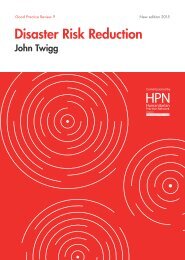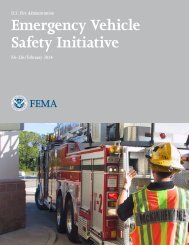Observer
2aEAQDf
2aEAQDf
You also want an ePaper? Increase the reach of your titles
YUMPU automatically turns print PDFs into web optimized ePapers that Google loves.
terns may form barriers to care-seeking. This perspective<br />
was represented by a DCM, contracted through FEMA,<br />
who stated, “Someone who did nothing, waited around<br />
for handouts, took no initiative to make themselves more<br />
resilient… [the process] cut off a lot of people who could<br />
really benefit from [federal] resources.” In practice, there<br />
were many reasons that the culture of Staten Islanders<br />
may have made them appear to outsiders as if they “took<br />
no initiative” to engage with unfamiliar sources of assistance.<br />
Government assistance<br />
The local patterns apparent in the process of seeking, or<br />
not seeking, government financial assistance in general<br />
on Staten Island are also significant. Many long-term residents<br />
of Staten Island view themselves as highly autonomous<br />
with respect to their financial needs, and prefer to<br />
seek help from families and friends in time of need. In good<br />
times this behavior manifests itself in having members of<br />
these networks do home repairs and improvements that<br />
may not conform to building code standards. In times of<br />
need people can be reluctant to admit the severity of their<br />
situation to an institutional representative, or to someone<br />
they perceive to be a “stranger.” One agency informant (a<br />
Staten Island native) described a scenario in which an affected<br />
resident answered the door to a group of volunteers<br />
by asking “Are you from Staten Island?” before even discussing<br />
his potential needs.<br />
Additionally, DCMs reported a range of ideological barriers<br />
in connecting their clients with the right type of assistance:<br />
“There is a stigma of public assistance.”<br />
“Lack of trust regarding what is being done with personal<br />
information.”<br />
“Clients are [increasingly] resistant to agencies offering<br />
assistance after being bounced around numerous times –<br />
“prior promises to help not coming through.”<br />
When residents did seek help, particularly in the form of<br />
assistance with rebuild efforts, they faced what felt like<br />
a staggering stream of bureaucratic processes to wade<br />
through, including rules or restrictions that seemed designed<br />
to withhold aid. In one example, a woman whose<br />
apartment burned down because electrical boxes exploded<br />
during the storm was told that “FEMA did not have a<br />
box for fire” but would try to file her claim and update<br />
it “when that box [was] put on the form.” Another commonly<br />
reported problem among my informants was their<br />
struggle initially to get coverage for flood and hurricane<br />
damage because their insurance “did not cover damage<br />
from a ‘Superstorm’.” For some residents who did receive<br />
rebuild monies from FEMA, they are now reliving their<br />
original struggles: FEMA has begun to send notices to<br />
some households saying that their losses were overestimated<br />
and they will need to pay back some of the money—money<br />
they have already spent on their rebuild. For<br />
residents who had little experience with government agencies<br />
before the storm, their experience on the whole has<br />
severely damaged what little trust they may have felt for<br />
those institutions. 4<br />
Vulnerabilities in culture, potential strengths in<br />
culture<br />
Few lifelong residents in the communities most affected<br />
by Sandy on Staten Island had much previous experience<br />
with any agency that provided the kind of assistance they<br />
would ultimately need during the recovery. Additionally,<br />
strong cultural beliefs commonly held within the<br />
communities most affected by Sandy on Staten Island led<br />
many residents to a false sense of economic security. Due<br />
to steady increases in homeownership, and participation<br />
in a cash economy that helps to minimize tax payments,<br />
many survivors, over several generations, have acquired<br />
a seemingly middle-class lifestyle. Many, however, were<br />
4 It is beyond the scope of this study to deal in-depth with the question<br />
of what Freudenburg (1993) deemed “recreancy” or “the failure of<br />
institutional actors to carry out their responsibilities with the degree of<br />
vigor necessary to merit the societal trust they enjoy” (909). However, this<br />
problem surely plays a role here. The management of the Build it Back<br />
program (see Stringer 2015) is a good example.<br />
Natural Hazards <strong>Observer</strong> • June 2016 13







